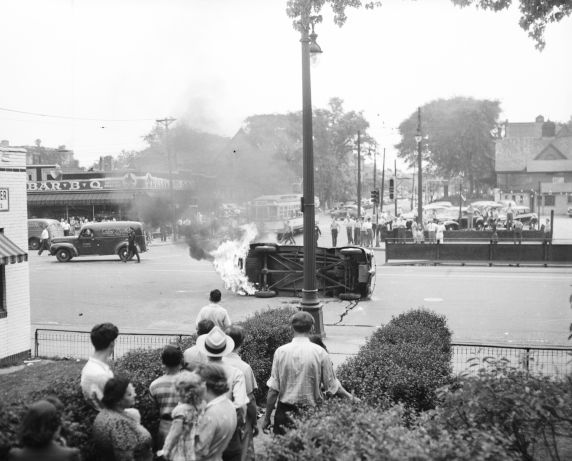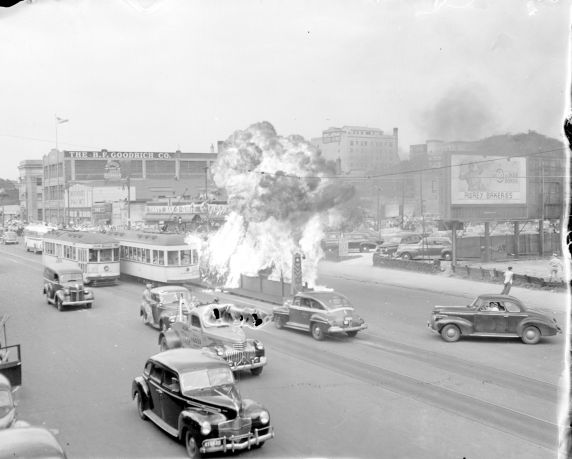cole phelps
Superstar
The Detroit Race Riot broke out in Detroit, Michigan, in June,1943, and lasted for three days before Federal troops regained control. The rioting between blacks and whites began on Belle Isle on June 20, 1943, and continued until June 22, killing 34, wounding 433, and destroying property valued at $2 million.
Events leading up to the riot


Sign in response to proposed Sojourner Truth Housing Project, February 1942.
Detroit, like many places in the United States, has a long history of racial discrimination. By the 1920s the city had become a stronghold of the Ku Klux Klan and the Black Legion, organizations committed to white supremacy.[2] In summer 1943, in the midst of World War II, tensions between blacks and whites in Detroit were escalating. Detroit's population had grown by 350,000 people since the war began. The booming defense industries brought in large numbers of people with high wages and very little available housing.
In recent years, 50,000 blacks and 300,000 whites had arrived, mostly from rural Appalachia and the American South.[3] Ethnic groups were pressured to resent African Americans especially. A historian of Detroit's Poles found that they were scared into seeing African Americans as "threatening their jobs, homes, communities, and churches".[4]
Recruiters convinced blacks as well as whites in the South to come up North by promising them higher wages in the new war factories. Believing that they had found a promised land, blacks began to move up North in larger numbers. However, upon arriving in Detroit, blacks found that the northern bigotry was almost as bad as that they left behind in the deep South. They were excluded from all public housing except Brewster Housing Projects, forced to live in homes without indoor plumbing, and paid rents two to three times higher than families in white districts. They also faced discrimination from the public and unfair treatment by the Detroit Police Department.[5] Job-seekers arrived in such large numbers in Detroit that it was impossible to house them all.
Before the attack on Pearl Harbor, the U.S. government was concerned about providing better housing for the workers throughout the country. On June 4, 1941, the Detroit Housing Commission approved two sites for defense housing projects--one for whites, one for blacks. The site originally selected by the commission for black workers was in a predominantly black area, but the U.S. government chose a site at Nevada and Fenelon streets, an all-white neighborhood.
The completed housing development that was designated for blacks was named Sojourner Truth, in memory of the black Civil War abolitionist and women's rights advocate. Many whites fiercely opposed allowing blacks to move into an all-white neighborhood. On January 20, 1942, Washington DC informed the Housing Commission that the Sojourner Truth housing project would be for whites and another would be selected for blacks. But when a suitable site for blacks could not be found, Washington D.C. housing authorities agreed to allow blacks into the finished homes, beginning February 28, 1942.[6]
On February 27, 1942, with a cross burning in a field near the homes, 150 whites vowed to keep out any black homeowners. By the following morning the crowd of whites – many armed – had grown to 1,200. Blacks who had already signed leases and paid rent attempted to get through the whites' picket line, leading to a clash between white and black groups.[7] Despite the mounting opposition from white groups, black families moved into the project at the end of April. To prevent violence, Detroit Mayor Edward Jeffries ordered the Detroit Police Department and state troops to keep the peace during the move. Over 1,100 city and state police officers and 1,600 Michigan National Guard troops were mobilized and sent to the area around Nevada and Fenelon streets to guard six African-American families who moved into the Sojourner Truth Homes. Eventually, 168 black families moved into the homes.[8]
Later, in June 1943, three weeks before the riot, Packard Motor Car Company promoted three blacks to work next to whites in the assembly lines. In response, 25,000 whites walked off the job, effectively slowing down the critical war production. It was clear that whites who worked with blacks in the same plant nevertheless refused to work side-by-side with them. During the protest, a voice with a southern accent shouted in the loudspeaker, "I'd rather see Hitler and Hirohito win than work next to a ******."[9]
Events leading up to the riot


Sign in response to proposed Sojourner Truth Housing Project, February 1942.
Detroit, like many places in the United States, has a long history of racial discrimination. By the 1920s the city had become a stronghold of the Ku Klux Klan and the Black Legion, organizations committed to white supremacy.[2] In summer 1943, in the midst of World War II, tensions between blacks and whites in Detroit were escalating. Detroit's population had grown by 350,000 people since the war began. The booming defense industries brought in large numbers of people with high wages and very little available housing.
In recent years, 50,000 blacks and 300,000 whites had arrived, mostly from rural Appalachia and the American South.[3] Ethnic groups were pressured to resent African Americans especially. A historian of Detroit's Poles found that they were scared into seeing African Americans as "threatening their jobs, homes, communities, and churches".[4]
Recruiters convinced blacks as well as whites in the South to come up North by promising them higher wages in the new war factories. Believing that they had found a promised land, blacks began to move up North in larger numbers. However, upon arriving in Detroit, blacks found that the northern bigotry was almost as bad as that they left behind in the deep South. They were excluded from all public housing except Brewster Housing Projects, forced to live in homes without indoor plumbing, and paid rents two to three times higher than families in white districts. They also faced discrimination from the public and unfair treatment by the Detroit Police Department.[5] Job-seekers arrived in such large numbers in Detroit that it was impossible to house them all.
Before the attack on Pearl Harbor, the U.S. government was concerned about providing better housing for the workers throughout the country. On June 4, 1941, the Detroit Housing Commission approved two sites for defense housing projects--one for whites, one for blacks. The site originally selected by the commission for black workers was in a predominantly black area, but the U.S. government chose a site at Nevada and Fenelon streets, an all-white neighborhood.
The completed housing development that was designated for blacks was named Sojourner Truth, in memory of the black Civil War abolitionist and women's rights advocate. Many whites fiercely opposed allowing blacks to move into an all-white neighborhood. On January 20, 1942, Washington DC informed the Housing Commission that the Sojourner Truth housing project would be for whites and another would be selected for blacks. But when a suitable site for blacks could not be found, Washington D.C. housing authorities agreed to allow blacks into the finished homes, beginning February 28, 1942.[6]
On February 27, 1942, with a cross burning in a field near the homes, 150 whites vowed to keep out any black homeowners. By the following morning the crowd of whites – many armed – had grown to 1,200. Blacks who had already signed leases and paid rent attempted to get through the whites' picket line, leading to a clash between white and black groups.[7] Despite the mounting opposition from white groups, black families moved into the project at the end of April. To prevent violence, Detroit Mayor Edward Jeffries ordered the Detroit Police Department and state troops to keep the peace during the move. Over 1,100 city and state police officers and 1,600 Michigan National Guard troops were mobilized and sent to the area around Nevada and Fenelon streets to guard six African-American families who moved into the Sojourner Truth Homes. Eventually, 168 black families moved into the homes.[8]
Later, in June 1943, three weeks before the riot, Packard Motor Car Company promoted three blacks to work next to whites in the assembly lines. In response, 25,000 whites walked off the job, effectively slowing down the critical war production. It was clear that whites who worked with blacks in the same plant nevertheless refused to work side-by-side with them. During the protest, a voice with a southern accent shouted in the loudspeaker, "I'd rather see Hitler and Hirohito win than work next to a ******."[9]





































